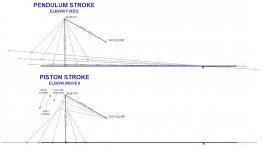I don't believe the mass of the arm can be brought to bear on the CB because of the flexing of the soft skin of the grip hand. See Dr. Dave's explanation here: https://billiards.colostate.edu/faq/grip/light-vs-tight/
Sorry, I didn't read all of your post, so I might have misunderstood you.
Speaking of it, have you considered adding a "tl;dr" summary paragraph to your long technical posts? They look interesting, but they're too long for me and I'd like having a way to choose which ones to wade into. Who knows, it might even increase your readership...
pj
chgo
Look for poolmanis videos on YouTube. Lately he has 2 videos shooting one handed. The one handed stroke uses the full arm.
https://youtu.be/rkCnCJZmBhg
The momentum he gets isn’t from the short stroke he employs, it can’t achieve a significant velocity. The momentum is generated primarily by the use of mass. The momentum is generated by the forward motion of the arm and even body when he needs even more. Once in motion the contact of the tip on the ball is so brief that there is no pillowing effect. Also the moment at which the pillowing effect would occur would be when transitioning forward, before any forward movement. It would have to be overcome first before any forward movement could happen. Once that initial resistance is overcome, the forward momentum is established, and won’t be undone at the moment of impact.
Fran this is not based on theory but actual use. The Dell Hill videos and explanation tell us what he taught Ronnie O’Sullivan and other World Champions. He is the World Snooker head coach. Learning and understanding progresses in all sports. Evolving often means leaving old ideas behind as new understanding emerges, it’s the hallmark of progress. Nobody is asking anybody to change. Today’s players need to write their own chapters and create new nostalgia for tomorrow’s generations. Carbon fiber means straight shafts forever. Low deflection is another advancement. Advancement in technique also evolves. Sometimes it seems radical like the Fosbury Flop. The use of the whole arm to help drive the cue through is hardly radical unless you are holding onto old concepts.
As Denise McCluggage said “ Change is the only constant, holding on the only sin.“
Last edited:
